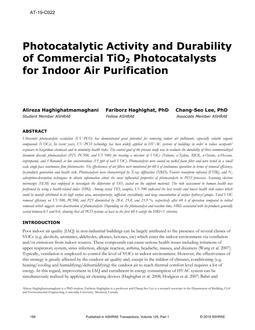Click here to purchase
Ultraviolet photocatalytic oxidation (UV-PCO) has demonstrated great potential for removing indoor air pollutants, especially volatile organiccompounds (VOCs). In recent years, UV-PCO technology has been widely applied in HVAC systems of buildings in order to reduce occupants’exposure to hazardous chemicals and to minimize health risks. The central goal of the present study was to evaluate the durability of three commercializedtitanium dioxide photocatalysts (P25, PC500, and UV100) for treating a mixture of VOCs (Toluene, o-Xylene, MEK, n-Octane, n-Hexane,isopropanol, and 1-Butanol) at low concentrations (15 ppb of each VOC). Photocatalysts were coated on nickel foam filter and were tested in a smallscale single-pass continuous flow photoreactor. The effectiveness of air filters were monitored for 60 h of continuous operation in terms of removal efficiency,by-products generation and health risk. Photocatalysts were characterized by X-ray diffraction (XRD), Fourier transform infrared (FTIR), and N2adsorption-desorption techniques to obtain information about the most influential properties of photocatalysts in PCO processes. Scanning electronmicroscopy (SEM) was employed to investigate the dispersion of TiO2 coated on the support material. The risk assessment to human health wasperformed by using a health-related index (HRI). Among tested TiO2 samples, UV100 indicated the best results and lowest health risk values whichcould be mainly attributed to its high surface area, micsorporosity, sufficient crystallinity, and large concentration of surface hydroxyl groups. Total VOCremoval efficiency on UV100, PC500, and P25 diminished by 28.4, 25.8, and 23.9 %, respectively after 60 h of operation compared to initialremovals which suggests sever deactivation of photocatalysts. Depending on the photocatalyst and reaction time, HRIs associated with by-products generallyvaried between 0.1 and 0.6, showing that all PCO systems at least in the first 60 h satisfy the HRI<1 criterion.
Citation: 2019 Winter Conference, Atlanta, GA, Conference Papers
Product Details
- Published:
- 2019
- Number of Pages:
- 9
- Units of Measure:
- Dual
- File Size:
- 1 file , 2.3 MB
- Product Code(s):
- D-AT-19-C022
